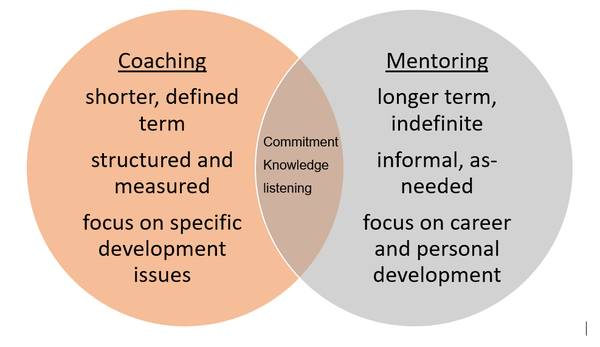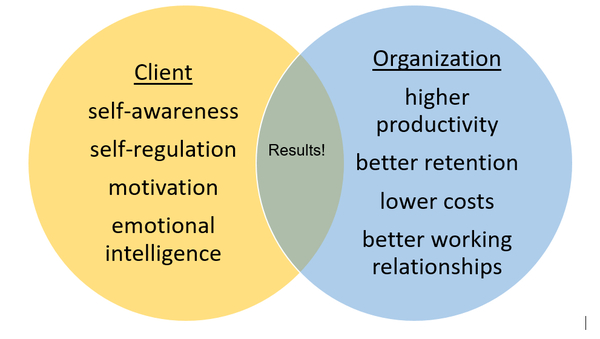THE WORLD’S #1 EXECUTIVE COACHING AND BUSINESS COACHING BLOG SINCE 2017.
Executive Coaching Definition, Stages, Benefits, Strategies & Results
August 13, 2024 | Category: Blog, Executive Coaching | Last updated on: March 12, 2025
Executive coaching may be regarded differently by different people. While there may still be some people for whom the concept of “coaching” may carry connotations of remediation, for the most part, this outdated idea has fallen by the wayside.
Rarely do organizations invest in coaching except for highly valued talent.
Who is an Executive Coach – Definition
Executive coaching assists top executives, managers, and other identified leaders in performing, learning, staying healthy and balanced, and effectively guiding their teams to successfully reach desired goals and exceed individual and corporate expectations.
The International Coaching Federation defines coaching more broadly as “partnering with clients in a thought-provoking and creative process that inspires them to maximize their personal and professional potential. The process of coaching often unlocks previously untapped sources of imagination, productivity, and leadership.” (International Coaching Federation, 2024)
We will focus more closely on executive coaching engagement and not coaching in general.
Executive Coaching Defined
This International Coaching Federation definition of coaching helps us define all coaching sub-categories, such as corporate coaching, career coaching, performance coaching, business coaching, leadership coaching, and, of course, executive coaching.
Executive coaching can be defined as a process that enables leaders to unlock and unleash their full potential, bringing greater value and abundance to the people and entities they serve.
When today’s executives decide on executive coaching for themselves, or perhaps it is recommended by the Board of Directors (in the case of a CEO), the connotations are almost always positive.
It says on behalf of the organization, “We believe in you, your leadership skills, and your ability to do great things. We’re willing to invest in executive coaching so you can fulfill your potential, and we can all enjoy the benefits.”
Coaching as a Vote of Confidence
Excellent coaching doesn’t come cheap, and no organization is going to invest in a top executive coach for a person they don’t believe in or hope to be rid of in a year or two.
Basically, if your company wants you to have an executive coach, you can take it as a vote of confidence that they think you’re capable of great things, and they hope to keep you around for the long term.
Bringing in a coach represents a certain kind of risk to an organization. An executive coach is expected to be unbiased and free of favoritism, and this level of honesty can sometimes create sensitivities among the executive team.
However, most businesses recognize that investing in their leaders produces a positive, lasting return on investment.
Whether you’re the executive or represent a business interested in investing in executive coaching, here is what you can expect from it.
Differences Between Executive Coaching and Mentoring
Many people wonder whether coaching (executive, business, or performance) and mentoring are the same. While there are similarities, coaches and mentors do different things and have different motivations and end goals.
Mentoring focuses on shaping a professional’s values and beliefs from the perspective of someone in the industry or the same company who has relevant experience and is willing to share wisdom gained over the years. This provides long-term benefits.
Coaching in general, and especially executive coaching, coaching focuses on the client’s professional development and their ability to improve self-awareness, set goals, work toward them, and improve specific aspects of performance.
Mentoring Relationship
More specifically, a mentoring relationship typically has the following characteristics:
- The mentor relationship is generally an ongoing relationship that may last for years or even decades.
- Mentoring frequently involves informal information sharing when the mentee needs support, guidance, or advice.
- Mentors are often more experienced versions of their mentees, working in the same profession or even in the same company.
- The focus of mentoring is the development of the mentee’s career and personal development, with the agenda largely set by the mentee.
Coaching Relationship
- Coaching relationships differ in that they usually have a set starting and ending point.
- Coaching sessions between coach and client are typically structured and scheduled and focus on specific developmental or leadership issues.
- Executive coaches are generally hired from outside the organization and may or may not have the same skills as the client. But that’s OK because the focus is on specific developmental issues in the workplace and on achieving specific goals. Goals vary, but examples may include learning to delegate effectively or improving communication skills.
Mentorship vs Coaching Diagram
The following diagram shows the differences and overlaps between mentoring and coaching.
Coaching Needs for Executives at Different Life Stages
It only makes sense that the thirty-ish executive who has zoomed up the career ladder has different coaching needs than the 50-year-old who has been in the industry since college.
Often, but not always, the younger leader needs more nurturing and more directness, while the older leader is often more aware of deficiencies that need to be addressed.
Goals and needs differ between the young executive and the more mature executive.
A study of 72 executive coaching relationships covering the period of 2008 through 2014 examined executive scores on personality and emotional intelligence tests, interviews with their superiors, and case notes.
The average coaching engagement lasted six to 12 months, and there were slightly more male coaching clients than female clients.
Differences Between Younger and Older Executives
The study found that regardless of gender, younger executives (in their thirties) had lower levels of self-awareness than older ones, and the changes they underwent were less dramatic than older executives.
Younger executives responded to specific guidelines and concrete recommendations, but they were less likely to wonder why those guidelines and recommendations were necessary.
Interestingly, the study found that executive behavior during executive coaching differed by age rather than generation, which is consistent with previous research describing the ongoing maturation that goes on throughout adulthood.
Researchers identified three factors that they believe account for differences among younger and older recipients of executive coaching:
- Younger executives often perceive themselves as winners and are likelier to view coaching as a perk of being at the top.
- Younger executives had more difficulty recognizing nuances of human behavior and were more likely to use “black-and-white” thinking, like “There is a single ‘best’ idea that should prevail.”
- Younger executives were likelier to believe that there is one right way to do things, while older executives were more willing to try different approaches.
The Role of Executive Coaches in Enhancing Executive Performance
Clearly, many organizations use executive coaching because it’s a $1.5 billion-per-year industry, with most of the biggest enterprises now using coaches.
Who is it for? Executives who want to:
- Improve self-confidence
- Strike a better work-life balance
- Open up new career opportunities
- Become a more effective leader
Making coaching work requires that organizations and the people running them prioritize coaching.
Executive coaching should never be treated as an afterthought or an “extra” but as an essential part of developing maximum leadership potential.
At the same time, it’s important that companies do not overuse coaching or think that coaching can solve deeply entrenched organizational (or personal) problems.
Coaching can be remarkably powerful, but it can’t do the impossible.
What Are the Benefits of Executive Coaching?
While specific outcomes of executive coaching depend on the goals that the coach and client set at the beginning of their work together, many more overarching benefits have been reported by clients and companies that have used executive coaching.
Among the benefits of executive coaching are:
- Increased self-awareness
- Increased self-regulation
- Greater empathy and emotional intelligence
- Flexible thinking replacing rigid thinking
- Higher levels of motivation
- More effective leadership
Benefits of executive coaching may carry over into non-work life as well.
In addition, many coaching clients indicate that they come away from their coaching engagement with better social skills, a growing professional network, a better online reputation, and a better non-work life.
Progressing Towards Your Goals
The specific improvements that a coaching client should expect as a result of coaching will involve their goals.
In addition to helping the client develop those goals, the effective executive coach will devise ways to measure progress toward goals.
For example, if an executive has difficulty delegating tasks, the coach may interview several people who report to the executive to define the scope of the problem, help the client define what “better delegation” means and how it can be measured, and then follow up at the end of the coaching engagement to measure progress toward that goal.
The following diagram illustrates the benefits that both coaching clients and their organizations can expect from executive coaching.
My Philosophy and Strategies for Executive Coaching
The most successful executives aren’t investing in executive coaching when they ask for my services – they’re investing in results.
With decades of experience in the executive coaching industry, I developed the Intelligent Leadership (IL) Executive Coaching Blueprint.
John Mattone Executive Coaching Process
With my clients, I create a six to 12-month immersive leadership coaching journey that leads to business results and personal growth. I want my clients to unleash their full potential, so they can be the best possible leaders they can be.
I use my Executive Coaching Blueprint in my executive coaching sessions to strengthen clients’ inner-core and outer-core characteristics, and certify other executive coaches from around the world in this process.
As a result, our clients are able to realize four game-changing outcomes that serve them well in business and in their lives in general:
- Altruism
- Affiliation
- Achievement
- Abundance
These four qualities are the seeds of sustained greatness and a positive, lasting legacy as a leader.
The process begins with a meeting between the coaching client and the sponsoring executive team to discuss the goals of the coaching relationship and gain context and background information.
We also discuss the proposed roadmap for getting there and the type of schedule to expect.
For executive coaching to get results, a clear plan is necessary.
From Observation to Action
The executive coaching process continues with spending the rest of the day with the executive client so we can get to know each other as professionals and human beings.
The purpose of this time is to build a foundation of trust and rapport.
I assess the client’s inner and outer core capabilities using my general observations, a structured, in-depth interview, and objective assessment tools.
With most clients, I also schedule a day of shadowing, where I observe them at work, on calls, and in meetings to discover their leadership style.
In addition, I conduct 360-degree interviews with key stakeholders, including other executives, board members, people who report to the client, and a selection from the larger population of employees.
From these interviews and my Strategic-Tactical Leadership Index 360-Survey, I identify the client’s leadership strengths and areas for improvement.
On another day, we debrief and discuss the results of the assessments and the themes that have emerged from them.
The Importance of Core Purpose Statement
The next step in the coaching relationship is helping the client create their Core Purpose Statement that they envision themselves living by.
This statement captures the essence of the person and leader the client wants to become, the qualities they must develop, what they want to accomplish, and the contributions they want to make.
These statements must be clearly defined because they affect every other phase of the coaching relationship.
My coaching clients then use my proprietary tools to prepare their initial leadership professional development plan to strengthen their:
- Irrefutable strengths
- Unexpected strengths
- Indisputable development needs
- Unexpected development needs
With my support and presence, the client then meets with their constituents and stakeholders individually and collectively to share their commitment to becoming the best possible leader—which can only happen with their support, guidance, feedback, and input.
The information collected in these meetings helps finalize the client’s leadership development plan.
My ongoing performance coaching, support, and guidance, along with frequent interaction with stakeholders and constituents, help the client measure their progress toward the goals of their leadership development plan.
Does Executive Coaching Work for Everyone?
Sometimes, executive coaching doesn’t work out, and there are some common denominators when this happens. For example, an executive who doesn’t want coaching is unlikely to make good progress, and if the client’s superiors aren’t invested in the coaching process, it’s even worse.
Another reason executive coaching can fail is a lack of clear and measurable goals, or goals that the client developed thinking they represent what their supervisor wants them to work on.
The goals in executive coaching should be ones that the client wants passionately.
When a client is less than forthright when providing information for the coach to develop the plan of action, coaching can go off-track.
Lack of clear, measurable goals can severely limit the results of coaching.
Hiring an Executive Coach Is Not a Last-Resort Tool
When an organization uses coaching as a last-ditch effort for an executive who is faltering and needs “saving,” the whole point of coaching is missed.
Coaching as a response to a monumental mistake runs the real risk of being seen as a punishment.
And even if it’s not, coaching is often ineffective when it is the last resort.
Confusion between coaching and mentoring may result in less-than-stellar results.
There’s certainly much to be gained from a successful mentor-mentee relationship, but expecting a mentor to get the same results as a leadership coach is short-sighted.
Finally, coaching can fail because a coach lacks the necessary skills and is not sufficiently qualified for the job.
Plenty of self-appointed executive coaches out there see coaching as a side business or a way to earn money.
Coaching certification programs exist, and some are more meaningful than others.
But primarily, you need to select an executive coach who has experience and success coaching clients similar to yours.
How Do You Recognize the Results of Executive Coaching?
What do you envision when you think about your organization one year from now, with one of your most promising executives having successfully completed executive coaching with a qualified coach?
Perhaps you envision greater efficiency, less in the way of divisive office politics, or clearer goals and objectives.
Maybe you envision everyone showing up to work with greater motivation and more commitment. Those are worthy aspirations, of course, but it’s important to develop goals that can be assessed as a baseline at the beginning of the coaching relationship and after coaching is completed.
Any executive coach worthy of the title will use their coaching skills to assist the client (and the executive team in general) in defining goals.
They will also help devise ways to measure how well those goals are met. The interviews that the executive coach performs at the beginning and end of coaching should tell a clear story, too.
If direct reports say at the outset that the client doesn’t articulate expectations clearly, and this is distressing, what do they say once coaching has concluded?
Recognizing executive coaching’s results requires engagement with an experienced, skilled coach who can develop and define goals, measure baseline conditions, monitor progress, and assess conditions at the end of the coaching engagement.
If your proposed leadership coaching professional doesn’t seem interested in these critical tasks, you shouldn’t expect too much from them.
What to Look for in an Executive Coach
An executive coach you consider working with should be crystal clear about their executive coaching process and willing to share the results of using that process.
Their personal and professional history clearly must show their coaching style and ability to develop leadership skills in themselves and their clients.
Evasive responses or overweening enthusiasm may indicate that the person is more style than substance.
A great coach is honest about gathering feedback and understands the importance of having a unique outsider’s point of view.
To ensure the clearest picture, feedback should come from the client’s supervisors, peers, and direct reports to ensure the clearest picture.
A great leadership coach won’t give you evasive or unrealistic answers to your questions.
A Good Coach is Open About Their Executive Coaching Process
Your coach should be able to discuss their coaching process and their skills in depth and detail.
What tools do they use?
What specific skills have they helped previous clients with?
They should be proud to share references with you and name actual clients who have improved in measurable ways.
Finally, you should choose a coach that understands the importance of client confidentiality.
An executive coach who casually shares everything with a client’s supervisors or HR people will shatter the client’s trust and cast a pall of negativity over the entire process.
Glossary
Core Purpose Statement – a way of thinking of oneself in terms of an overarching statement about what their purpose and goals are
Emotional intelligence – a person’s ability to identify and manage their own emotions and to understand how their emotions affect and are affected by other people’s emotions
Executive coaching – professional coaching that focuses on development of leadership skills that are needed to facilitate positive change, manage complexity, and build high-performance teams
Intelligent Leadership Executive Coaching Blueprint – John Mattone’s plan for a six to 12-month immersive leadership and personal growth process designed to unlock an executive’s full leadership potential
Mentoring – an informal employee development system where a more senior, experienced professional (the mentor) acts as advisor or guide to a junior professional over the course of months, years, or decades
Self-awareness – the accurate assessment and understanding of one’s abilities, strengths, and weaknesses, and how they affect oneself and others
Self-regulation – a person’s ability to monitor and control their behavior, emotions, or thoughts, and modify them in accordance with situations and conditions
Stakeholders – in this context, the people affected by the actions of the coaching client. They may include the coaching client’s peers, supervisors, direct-reports, or other employees.










